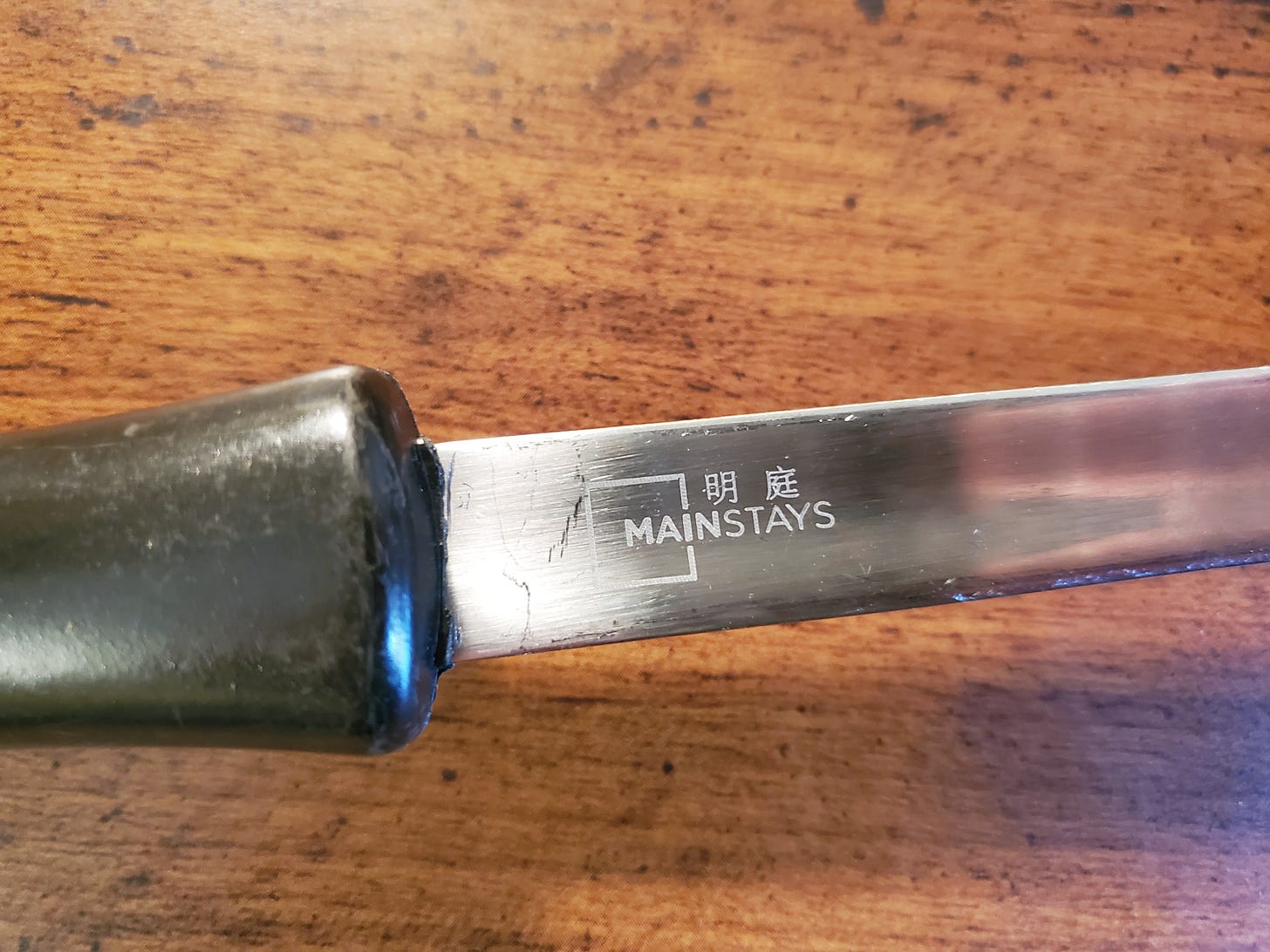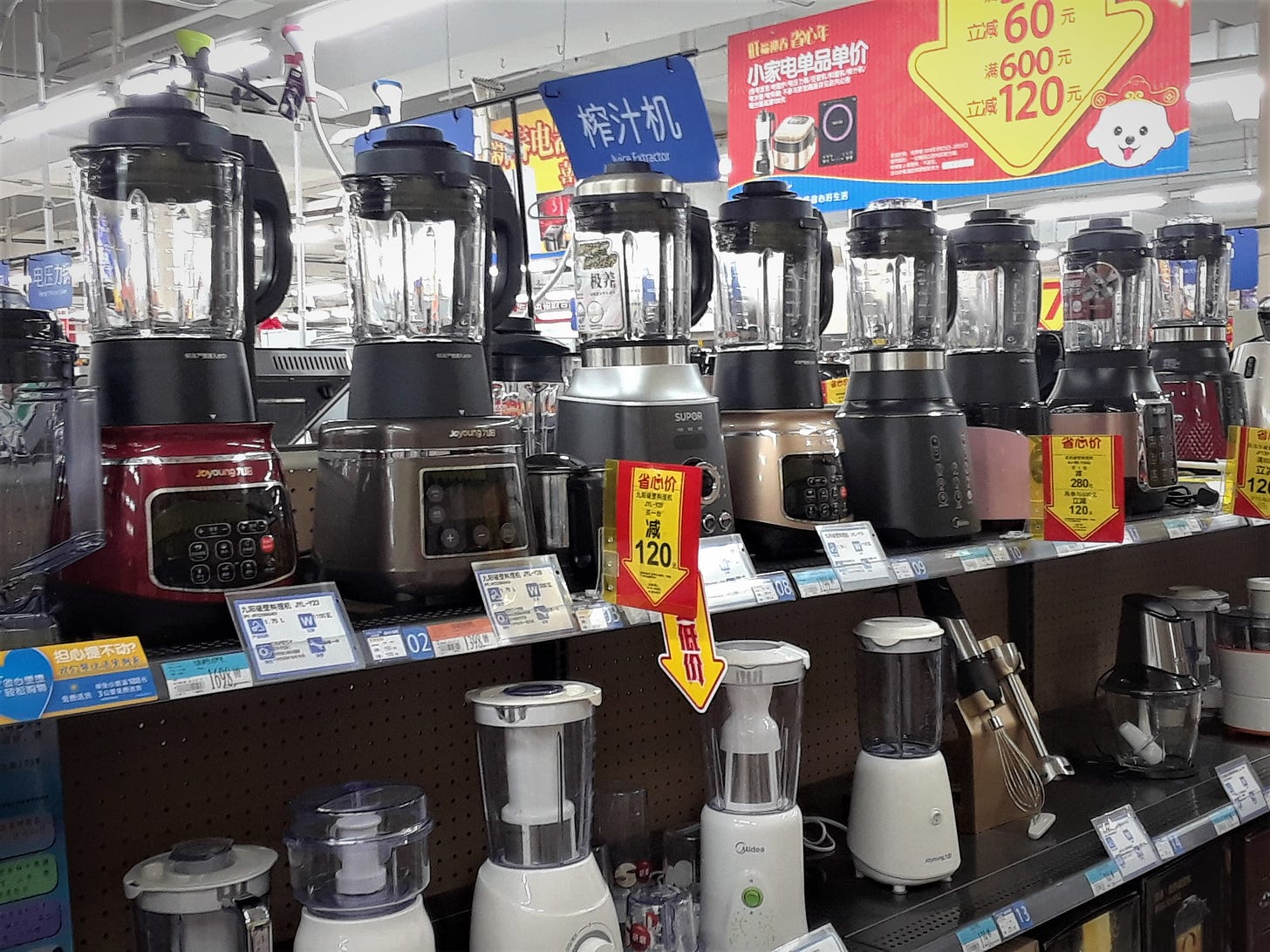Take a look at these two spatulas my wife and I own:
We bought these during a 2018 visit to China, at a Walmart! The top one is a wok scraper, made by the Chinese small appliance and kitchenware company Supor. The bottom one is a plain old spatula, and it’s actually the Walmart store brand:
I bought these because they were cheap, and struck me as being of much better quality than similarly priced utensils in an American discount store. I remember an old spatula my dad bought at Walmart (for a dollar or so), and it was also made of stainless steel. However, it was very thin and cheap, and the spatula part was a separate piece welded to the handle. In just a couple of weeks, the welding broke, and the spatula part fell off the handle.
When you just search “spatula” on the Walmart website, the first stainless-steel spatula that comes up is this one. It has the same two-piece, welded design, which is pretty common for inexpensive stainless steel utensils.
I’ll note that the high-temperature plastic ones are almost always one piece, and very sturdy. However, they’re never as high-temperature as they claim. I replaced our nylon spatula with a bamboo one, several years ago, when I realized I could pull bits of melted plastic off the edge of it. Our bamboo spatula is about five years old, and it’s still in great condition.
Walmart does sell single-piece steel utensils, for more money of course—considerably more than the dollar equivalent of these two we bought in China. There’s a quality of craftsmanship here that surprised me initially and still impresses me every time I use them. The edges of the metal are smoothed and rounded, the metal is thick, the handles are comfortable, and of course they’re a single piece, with no stress points.
The Walmart we visited in China also sold cast-iron woks (we bought one too, and it’s still in excellent condition) and a wide range of small appliances, which appeared much more refined and better constructed than the small appliances I’m used to seeing here.
There were also lots of employees out on the floor, just available for any questions you might have (we discussed woks with one of them for several minutes.) I remember when I was a kid that Walmart had employees everywhere; my mom would ask me, “Go find someone to ask” whatever question we might have. At some point, the employees started disappearing, and you were on your own if you had any real questions.
Here are a couple of pictures, just of the appliance section:
Now when you think of Walmart, you think of cheaply made stuff. And when you think of Chinese manufacturing, you probably also think of cheaply made stuff. Why, then, did a Chinese Walmart have pretty inexpensive, higher quality stuff than an American Walmart?
Do Chinese consumers demand better quality? Do Chinese companies offer their best products only domestically? Does Walmart in the United States compete and push suppliers so hard on price that quality simply doesn’t make the cut?
I know this is just an anecdote, but I still remember how different that Walmart felt, and I don’t think I’ve ever seen a discount store in the United States that gave me the same impression of quality and selection.
It does, however, remind me of father’s first impression of Walmart, some time back in the early 1990s.
Later on, some time in the mid-2000s, he first started noticing a decline in the quality of Walmart stores, and he thought they were starting to feel junky. (That’s what he’d initially thought they were, before he’d ever been to one.) But back in the ’90s, he remembered seeing Dremel tools in the hardware department, and being impressed with the store’s combination of low prices and lots of name-brand merchandise. He felt it was a cut above the other discount chains of the era (almost all of which are defunct.)
As for me, I have the vague impression that the discount stores of my childhood were a cut above the ones we have today. And the Walmart in China felt like a different kind of discount store, one closer to our old version of this type of store.
Another angle here is that the stereotype of Chinese-made stuff as cheap and junky is outdated. One data point for that: my wife bought me an electric steamer, made by the Chinese company Buydeem, two Christmases ago. It’s durable, nicely styled, and works great. It feels like a better product than a lot of the stuff with an American brand name on it, but made in China or another low-cost country.
You’ve probably never heard of Buydeem, because they only entered the U.S. market a few years ago—after testing out and succeeding in the highly competitive Japanese and Korean markets. If they could compete with famously high-tech and well-designed Japanese appliances, they could probably compete with anything available in the United States.
It’s worth remembering that only a couple of decades separated the widespread availability of Japanese electronics in the 1960s—then widely considered junk—and the domination of Sony and other Japanese electronics manufacturers in the 1980s.
Has anyone else noticed any of this? I’d love to see your comments or emails.
And because this piece touches on a lot of threads, there are more related reading links than usual. Enjoy!
Related Reading:
Walmart, Sam’s Club, and...Bud’s?
A Repair Journey Through Low-Cost Manufacturing
Please consider upgrading to a paid subscription to help support this newsletter. You’ll get a weekend subscribers-only post, plus full access to the archive of over 300 posts and growing. And you’ll help ensure more material like this!









You got me at spatula! I had an occasion to organize my cooking tools, and I noticed I had like 18 spatulas! Not sure how that happened. You are so right about the quality and stress points. The dichotomy between Chinese and American consumers vs. demand for quality is obvious. I wonder why? Don't we care about what we buy?